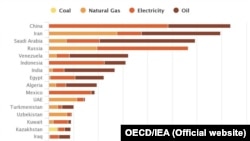The Iranian government has proposed to increase the gasoline price by 50% to 15,000 rials per liter (around 43 US cents or $1.62 per US gallon) in the budget bill for next fiscal year, starting on March 21.
The price of diesel is also set to increase by 33% to 4,000 rials per liter, or 10 cents per liter or 38 cents per gallon.
According to a report published on December 19, on the official government website, the rise in fuel prices would add $4.8 billion to the government’s revenues next year to help it invest in job creation, to reduce Iran’s high unemployment rate.
The report also says raising fuel prices to a more realistic level will reduce gasoline and diesel smuggling to neighboring countries, where the prices are much higher.
The fuel price hike will come into force once the parliament and the Guardian Council approve it.
Fuel prices, like many other necessities, have been heavily subsidized in the Islamic Republic’s closed and controlled economy. Also, hundreds of government-owned industries and companies have been subsidized, often just to keep people employed.
But realizing that the country could not afford to indefinitely subsidize the economy, Iran started reducing subsidies in 2010 by gradually eliminating inefficient government industries and adopting market price structures for essential goods.
Subsidies had cost the government $77 billion in 2008, or about 27% of GDP, according to World Bank estimates. Then, in order to soften the impact of reducing subsidies, the government launched a direct cash transfer program to Iranian households.
Since the beginning of former president Mahmoud Ahmadinejad’s second term, the cumulative direct cash handouts to households reached a significant level; to about $60bn. But this was much less than directly subsidizing goods and industries.
According to the International Energy Agency, Iran spent more than $34.7 billion for fuel subsidies in 2016, which indicates a huge reduction, compared to 2008.
Energy Subsidies by Country, 2016 (Million USD):
Source: International Energy Agency
But instead, President Hassan Rouhani’s administration has reduced cash handouts, first targeting around 3 million high income households, which have been removed from the cash transfer recipient list last years. As a result, the expenditures of the Targeted Subsidies Organization (TSO) is estimated to have declined to 3.4% of GDP in 2016 from 4.2% in 2014, World Bank estimated.
In next year’s budget bill, government has proposed further decline in cash handouts as well. It also plans to halve subsides for bread to $1.4 billion.
Impact on inflation rate
Iran with about 80 million liters per day gasoline consumption relied up to 16% on imports during the first half of fiscal year (March 21-September 22).
Rising fuel prices would increase Iran’s already high inflation rate, which dropped below 10% in the last two years, after soaring to 39.3% in 2013.
According to the International Monetary Fund, World Bank and other international organizations, the inflation rate will increase from 9.6% in the current year to 10.9% in 2018, even without the fuel price rise.
The index is expected to climb even higher if 50% increase in gasoline prices is implemented.
Ilham Shaban, director of the Caspian Oil Research Center told Radio Farda that not only Iran, but almost all oil exporting nations, addicted to energy subsidies, have to free up fuel prices.
“Last year, the value of fossil-fuel consumption subsidies in the world reached $260 billion and most of them have already raised fuel prices. Uzbekistan almost doubled the gasoline price, Azerbaijan increased 59%, Turkmenistan, Persian Gulf nations, especially Saudi Arabia, increased the prices as well.
Riyadh also plans to increase prices 80% by 2020. The oil producers suffer heavily from budget deficits in a low oil price era and have no choice but getting rid of subsides”.
He said that energy price rise accelerates inflation. “For instance, Uzbekistan’s inflation rate increased from 5.7% in 2016 to 12.7% in the current year. The rate in Azerbaijan also increased to 12.6%. But, there are various factors in this growth, like dropping national currency value by almost two times during last two years in these countries. By the way, the share of energy price hike was also significant”.





